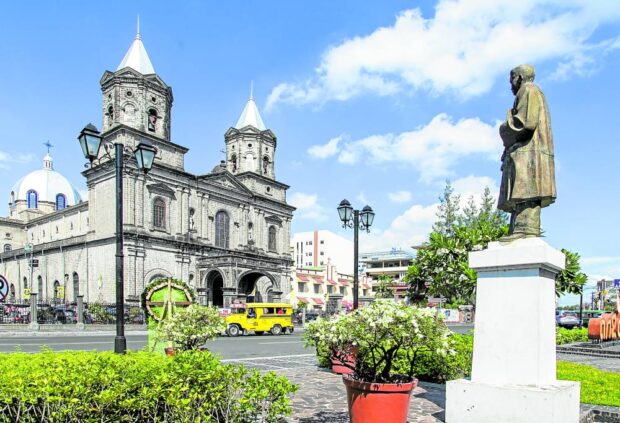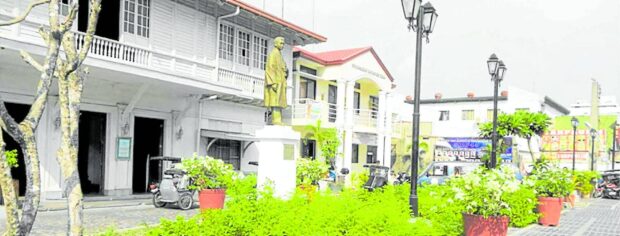Angeles City: From a forested area to a highly urbanized city

The Christmas tradition of “lubenas” or procession of saints in Angeles City (REYMOND T. OREJAS / FILE PHOTO)
The growth of Angeles City as one of the most thriving cities in the province of Pampanga was due to several factors, including its location, its history, and its people.
Angeles City is a land-locked city that is conveniently connected to Metro Manila, to other major cities of Pampanga, and to different provinces in Central Luzon. Its location at the path linking to different regions in Luzon has made it a strategic place to settle in, build infrastructure, and grow business activities.
Angeles City was also an important setting for several events in Philippine history and the prominence of these events has contributed to its rapid development as the first highly urbanized city in Central Luzon.
The city started as a forested area in the northern portion of San Fernando. Clearing out the area was initiated by a group led by Don Angel Pantaleon de Miranda who was San Fernando’s Capitan, the equivalent of a municipal mayor, in 1796. The clearing became a new settlement named Culiat, after the woody vine abundant in the area at that time until it became a barrio (now a barangay) of San Fernando up to Dec. 8, 1829.
The petitioned political separation of Culiat was granted in 1829 and it was renamed “El Pueblo de los Angeles” (Town of Angels) in honor of its patron saints, “Los Santos Angeles Custodios” (Holy Guardian Angels) and its founder, Don Angel.
Years later, in 1899, Angeles was made the seat of Philippine government by Gen. Emilio Aguinaldo who was traversing up north at the time of the revolutionary war.
It was also in Angeles that the first anniversary celebration of Philippine Independence was held after its proclamation a year earlier in Kawit, Cavite.
The first civil government of the United States in the Philippines was also founded in Angeles in 1900. This started the American presence in Angeles highlighted by the encampment of the US military forces in the area from 1902 until 1991.
Former US President Theodore Roosevelt signed an executive order designating 31 sq km of land in Barrio Sapang Bato as Fort Stotsenberg. The land area would later on expand to 632.14 sq km in 1908 to become Clark Air Base.
As part of the US military camp, Angeles witnessed the struggles during the Philippine revolutionary wars against American and Japanese forces and the devastation of World War II.
After World War II and following the declaration of Philippine Independence from the United States on July 4, 1946, the Philippine-American Military Bases Agreement was signed on March 14, 1947.
The bases agreement allowed the US to maintain territorial integrity and sovereignty over Clark Air Base and Subic Naval Base for the next 44 years.
Clark Air Base served as the tactical operational US air force installation in the entire Southeast Asian region with a capacity to accommodate all the US military transport planes serving the entire Western Pacific.
On Jan. 1, 1964, Angeles was converted into a chartered city under Republic Act No. 3700. Urbanization continued in Angeles City and despite the destruction caused by the eruption of Mt. Pinatubo in 1991, the resilience and discipline of the people of Angeles pushed the city to maintain its growth.
The establishment of economic zones and infrastructure investments in Central Luzon also contributed to the growth and urbanization of Angeles.
Angeles has been supporting the residential and commercial demands of the air base, even after it was converted into the Clark Freeport and Special Economic Zone. Its proximity to the Subic Special Economic and Freeport Zone and the Bataan Freeport Zone has also spurred access and trade in the city.
Big ticket infrastructure projects like the improvement of the MacArthur Highway, the construction of the North Luzon Expressway and Subic-Clark-Tarlac Expressway, and the opening of the Clark International Airport have increased the prominence of Angeles City as an investment center in Pampanga.
The flourishing economic activities in the city led to a construction boom as residential subdivisions and commercial districts, including malls, hotels, fast food chains, and restaurants began to populate the city. And yet the demand is still high because the city has more potential developments left to tap.
As a city with a rich heritage, the local government has heavily invested on heritage preservation projects as a way to boost its economy and the culture of the people in Angeles.
Some of the initiatives of the city government include the establishment of the old town proper as the Angeles Heritage District, establishment of the Plaza Angel, improvement of the walkability of the heritage district, development of pocket parks (Agyu Tamu Parks), and the construction of the Independence Plaza.
Complementing these are the cultural programs spearheaded by the Local Tourism Office and Kuliat Foundation, Inc. such as the promotion of the local cuisine and the establishment of the Center for Kapampangan Studies by the Holy Angel University.
The city has also put forward its plans to be an eco-friendly city and promote sustainable projects to address climate change.
In 2012, the city set up the “1 Million Tree Program”, which requires businesses to provide tree, palm seedlings or bamboo for the annual business permit renewal.
The seedlings are planted at the Sapangbato Watershed to maintain the existing secondary forest and along the Abacan River to protect the banks from erosion especially during extreme floods.
For waterways navigating through built up areas, the city government constructed riverwalls to safeguard citizens and their properties from flooding.
Several environment-focused programs like the streetscape project under the Balen Kuliat District, the Nepomuceno Streetscape, and an improvement of a plaza and park at the Amianan Section have also been funded by the 2018 Green Program of the Department of Budget and Management.
The balance of good urban planning and economic stimulation has contributed to the competitiveness of Angeles City. In 2022, the city government was named the fifth most improved highly urbanized city in the country in terms of economic development and competitiveness. It was the only HUC in Central Luzon to receive this award under the said category.
Sources: Inquirer Archives, angelescity.gov.ph, unhabitat.org.ph, DILG-Central Luzon website


